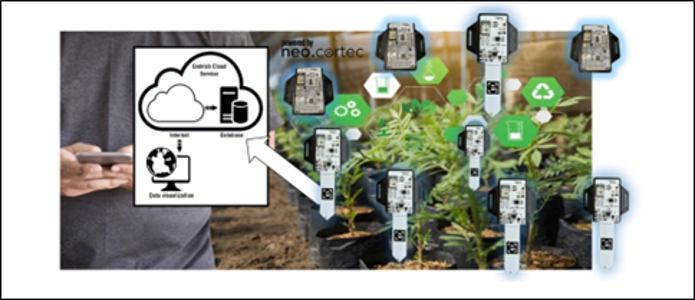
Soil moisture measurement with IoT solutions from endrich group
The wireless soil moisture sensors from the endrich group are linked together in a wireless ad-hoc network. The sensors work capacitively and generate data proportional to the soil moisture. The neo-Mesh-Network delivers this recorded data to the cloud via a single internet connection. The individual sensors at a distance of up to 100 metres act as repeaters and can therefore cover a large area. The energy required is generated by a solar panel integrated into the sensor, which also charges a battery for night-time operation.

Measuring soil moisture is one of the key elements of environmental monitoring and IoT solutions for agriculture and horticulture. It involves measuring the amount of water in the top layer of soil, which has a direct impact on plant growth, irrigation strategies and water conservation efforts. Various methods are used to determine soil moisture. These range from traditional methods such as gravimetric measurements to modern technologies such as capacitance measurement or TDR (Time Domain Reflectometry). The accurate measurement of soil moisture helps to optimise irrigation schedules, prevent over- or under-irrigation, promote sustainable agriculture and ultimately increase agricultural productivity while minimising water wastage. The addition of modern wireless communication units to traditional sensors and control electronics and the integration of the IoT makes it possible to use computational methods to create a picture of soil moisture conditions in large plantations from the data of many sensors.
In some areas, the lack of coverage of the cultivated areas with telecommunication services makes it impossible or uneconomical to use intelligent sensors with a direct sensor-cloud connection (GSM, SAT, etc.), for example. In such cases, a solution may be to organise the soil moisture sensors in an ad hoc wireless network using renewable energy sources and low power consumption modems that can cover a large area. To promote cost efficiency, this network will be provided with a single connection to the Internet. The gateway used can be a device operating in a property with an internet connection at the edge of the area, such as a gateway with a SAT connection integrated into the smart sensor mesh network.
In this case, low-consumption solutions for a local ad-hoc sensor network are required, using for example the NeoCortec Neo.Mesh protocol. A large number of smart sensors can be connected to a local sub-GigaHertz wireless network with low power consumption, in which a single gateway with an internet connection delivers the data to the cloud database via the mobile network. This can be realised with LTE-M or NB-IoT, for example, or even with a satellite or cable connection. This modular sensor network infrastructure provides multi-point-to-point communication to the cloud via the LPLAN-LPWAN/WAN gateway.
The wireless E-IoT soil moisture sensor from endrich works on the capacitive principle and sends a signal proportional to the moisture of the top soil layer via the neo.mesh network. The sensors are placed outdoors at a distance of up to one hundred metres from each other. Each sensor acts as a repeater and the data finds its way to the target gateway. A large number of thousands of these nodes thus cover a large area. During the day, the integrated solar panel provides energy for the electronics of each node, while at night the rechargeable battery ensures continuous operation.
Further information can be found at www.endrich.com.



